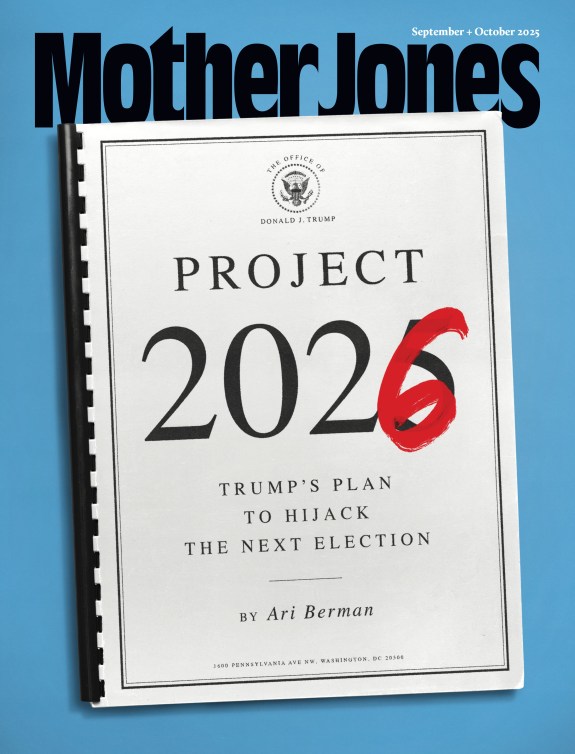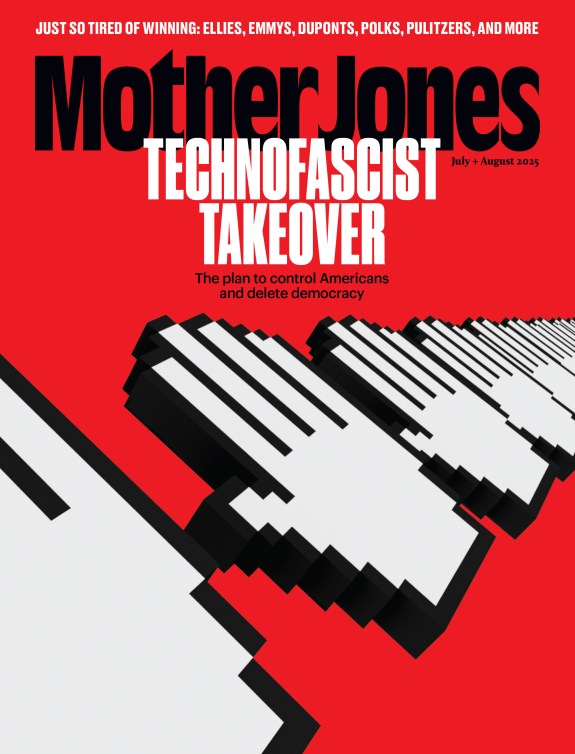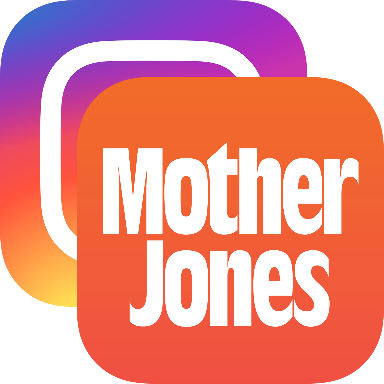After getting some pushback on this post about the Tara Reade accusations—both internally and externally, including from colleagues who report on sexual violence—I realized that it didn’t fully acknowledge all of the latest reporting or the science of trauma, and this gave it a tone I didn’t really intend. I may write again on this subject, but for now I think it’s best to take this one down. I apologize, and in the future I’ll take more time to work through posts on such sensitive topics.

Kevin Drum
A blog of my opinions. Plus charts and cats.
-
Real GDP plummeted 4.8 percent in the first quarter:

This is a little surprising: business lockdowns only started at the tail end of the quarter and shouldn’t have had a huge effect. This suggests that the economy may have been heading for a slide even before it got hit by the coronavirus pandemic.
The slowdown hit everywhere. Both personal consumption and private investment were down. Durable goods were down. Services were down. Fixed investment was down. Both imports and exports of services were down.
Among consumption of goods, the biggest drops were in autos and clothing. Among services, the biggest drops were in food, recreation, and health care. Among investment, the biggest drop was in business equipment.
All of this together suggests that the economy was on the edge of recession already, and both consumption and investment then cratered in response to fear of the coronavirus even before it had a concrete effect on the economy. Next quarter should be even worse.
On the other hand: I’ll point out yet again that it doesn’t feel like a typical economic implosion, does it? A drop of this magnitude would normally be accompanied by a huge amount of economic fear, but this time everyone knows exactly why the drop occurred and what has to happen to stop it. In the meantime, everyone also knows that massive government assistance is either here or on the way soon. Our fear right now isn’t truly economic, it’s fear of the virus. This means we can still get out of this with only moderate damage if we handle the pandemic itself properly.
-
Here’s the coronavirus death toll through April 28. After regaling you a couple of days ago about why I switched to numbers from the COVID Tracking Project for the United States, the Johns Hopkins folks apparently decided to fix up their numbers to be more consistent over time. So the US chart is now pure Johns Hopkins across the board.
At this point, it really does look like every country has reached its peak and is now declining. The big questions are (a) how fast will they decline? and (b) will relaxation of countermeasures cause a resurgence in a few weeks? I’m not sure there’s any good way to predict that. We’ll just have to wait and see.
The raw data from Johns Hopkins is here. The Public Health Agency of Sweden is here.
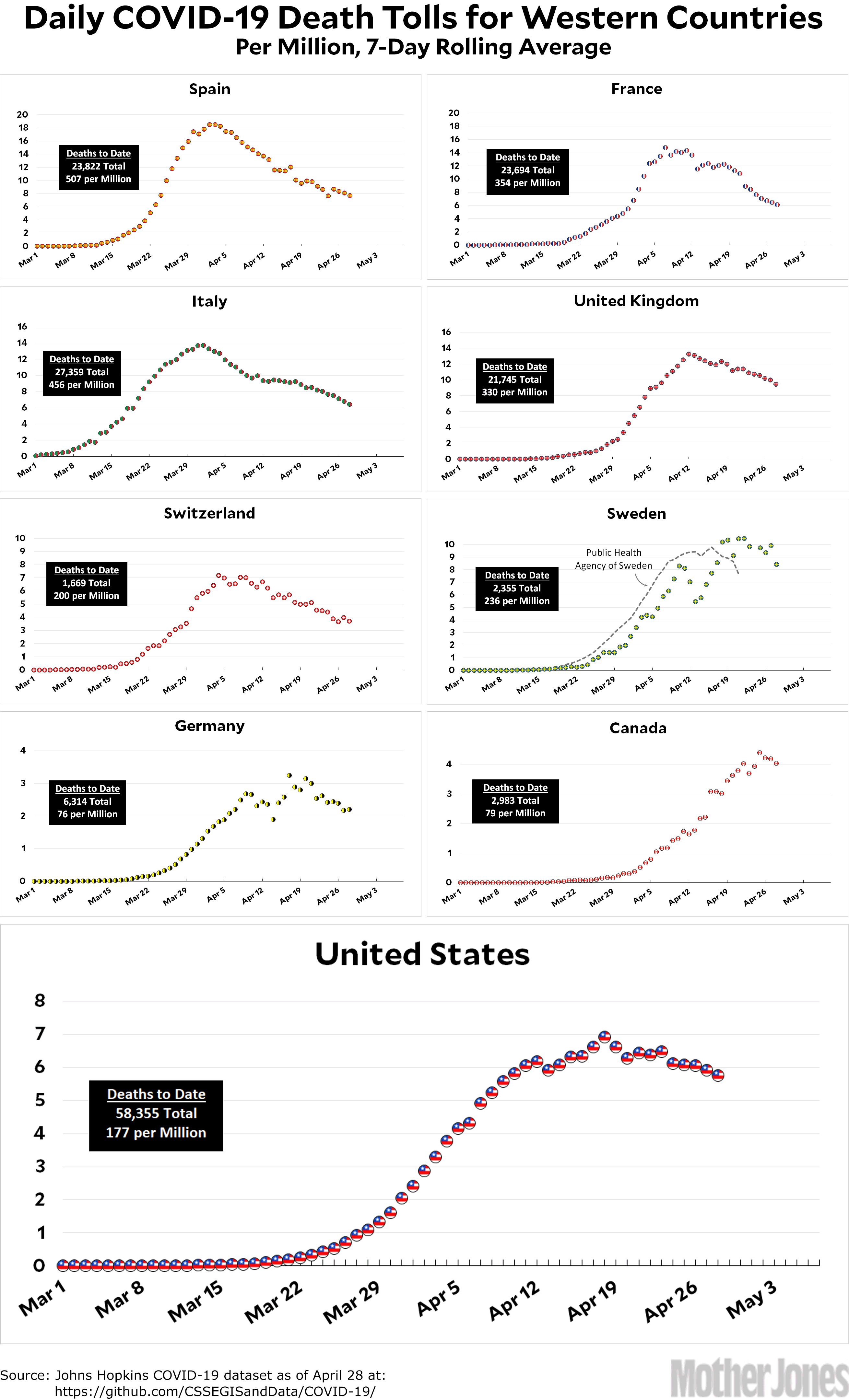
-
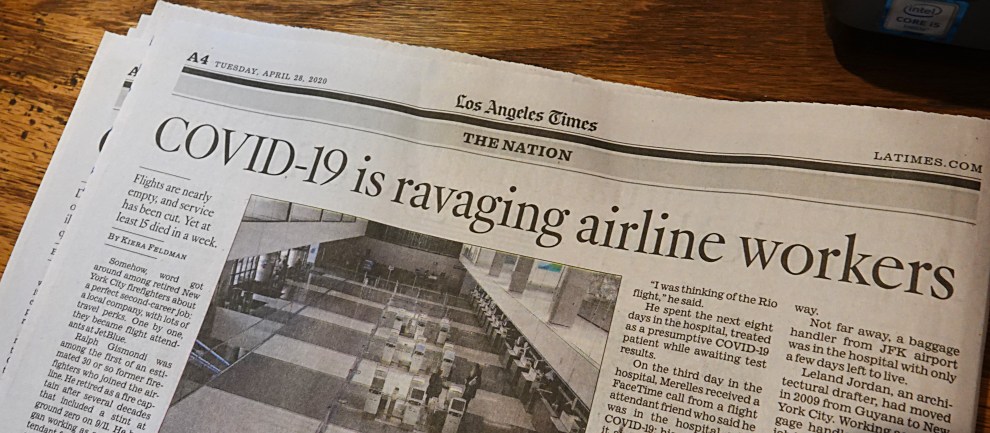
The LA Times continues to use all caps for COVID-19.Kevin Drum
How is the American press referring to COVID-19? Here’s a quick, semi-random survey:
- New York Times: Covid-19
- Washington Post: covid-19
- Wall Street Journal: Covid-19
- LA Times: COVID-19
- USA Today: COVID-19
- CNN: Covid-19
- Fox: COVID-19
- ABC: COVID-19
- NBC: COVID-19
- CBS: COVID-19
- AP Style: COVID-19
- Politico: Covid-19
- Stat: Covid-19
- San Francisco Chronicle: COVID-19
- Time: COVID-19
Among these outlets, the score is 9-6 in favor of keeping it all caps. Mother Jones generally follows AP style, so it’s all caps for us too.
In case you’re wondering, British style is to use uppercase for acronyms that are pronounced as separate letters when spoken but lowercase for acronyms that are pronounced as words when spoken. So NASA is Nasa and COVID is Covid, while FBI is FBI and USA is USA.
-
I have two recent C19 studies to share with you. The first concludes that people with cancer do worse than people without cancer. In particular, those with hematological cancers—like, say, multiple myeloma, just to pick an example out of a hat—do way worse:
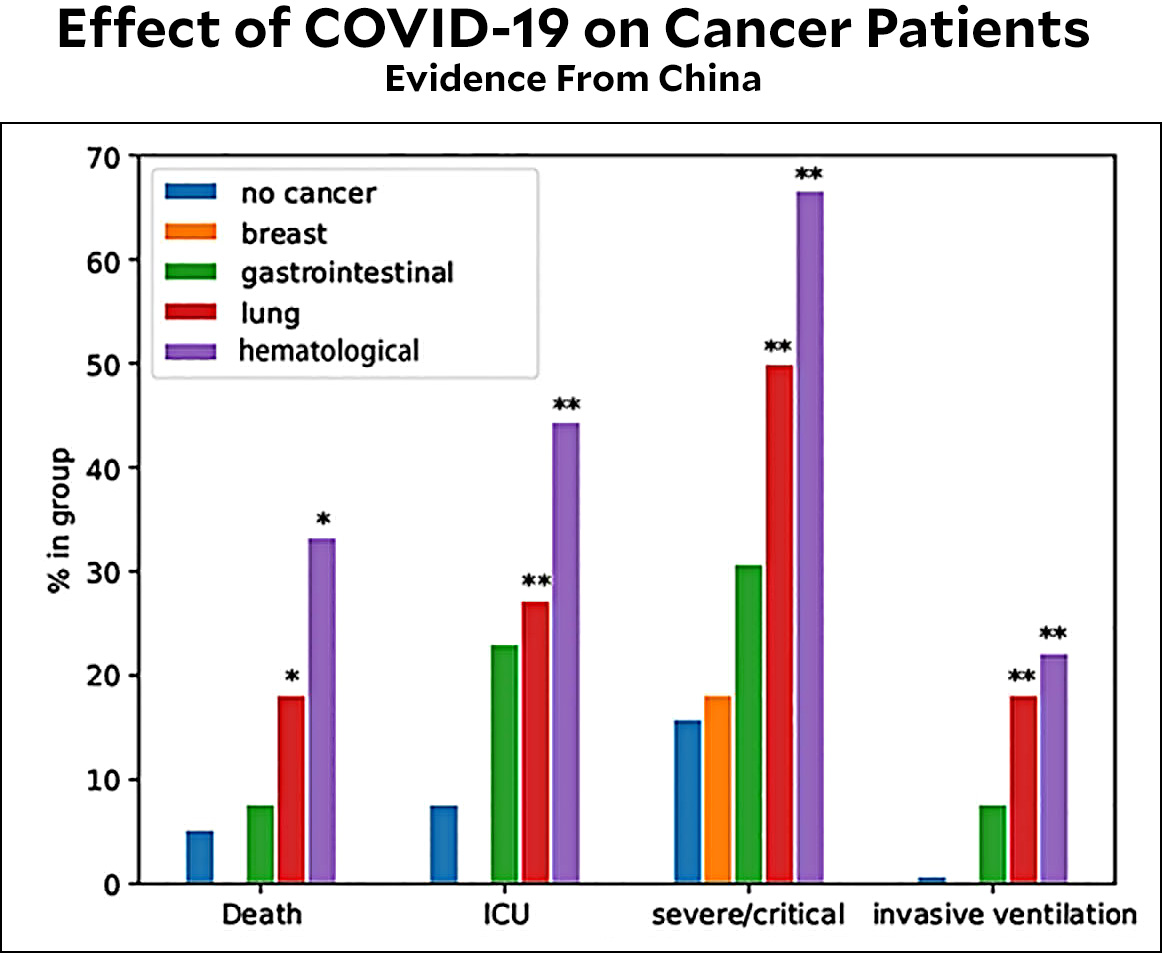
Yuck. The second study says that dense urban areas don’t do any worse than smaller, less dense towns:
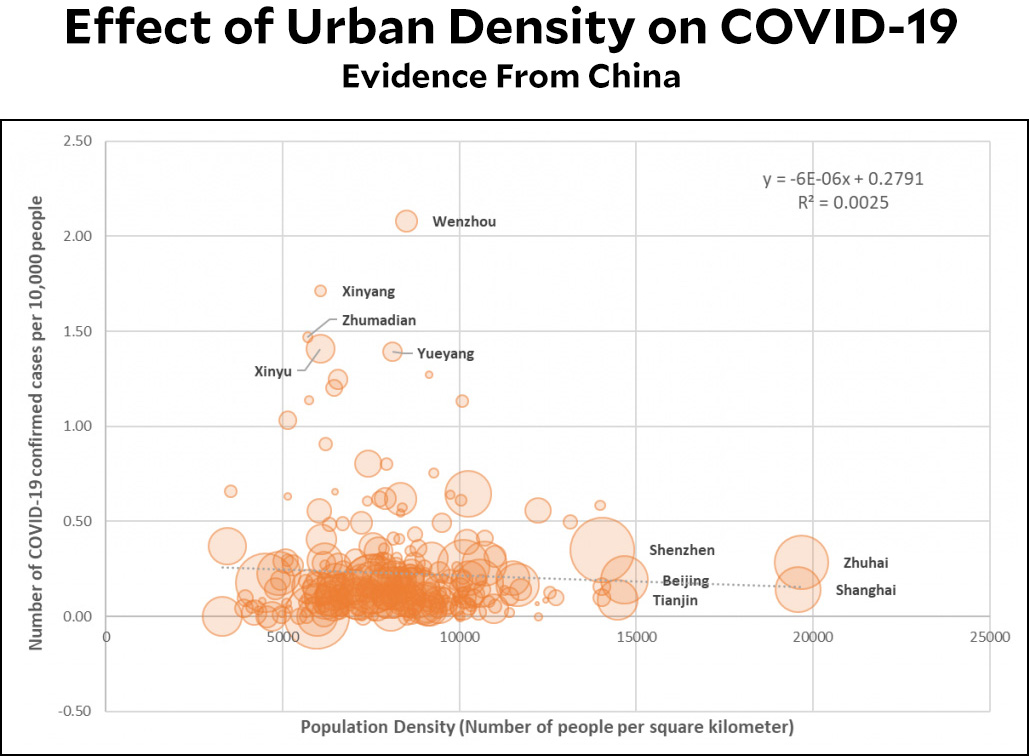
Hmmm. What to believe? There doesn’t seem to be anything obviously wrong with either study, but my stated prior belief is not to trust studies out of Wuhan because, for some reason, there just seems to be something different about Wuhan. But what about studies that include Wuhan but also other areas of China? Should I stick with my priors and be skeptical? Or should I judge them the same way I’d judge any other study? Decisions, decisions.
-

The Rev. Thomas Bayes, whose simple and fairly narrow formula eventually inspired a vast new field of statistics.
It is really, really hard to find stuff to write about other than the C19 pandemic. So instead, how about a complicated post about Bayesian statistics? The underlying study that prompted this post is, unfortunately, about coronavirus testing, but it’s really about Bayesian statistics. Honest.
Bad news first: most of you probably don’t know what Bayesian statistics is, and it would take way too long to explain properly. I’m not even sure I could do a fair job of it, actually, so just skip this whole post if it’s not your thing. OTOH, if you’re really bored, go ahead and read it and then use the internet machine to enlighten yourself about the whole subject.
The whole thing starts with that Santa Clara study of C19 antibody testing. The authors concluded that the infection rate of the entire population was between 2.5 percent and 4.2 percent, which includes even those who had no symptoms and never knew they were infected. Unfortunately, the antibody test had a false positive rate of 1.5 percent, which means that the true range of the infection rate was about 0 to 5 percent.
So were the authors justified in using their narrower range of 2.5 to 4.2 percent? The loud and clear voice of the statistics community was no. But today, Andrew Gelman, who was quite critical of the study, writes this:
It seems clear to me that the authors of that study had reasons for believing their claims, even before the data came in. They viewed their study as confirmation of their existing beliefs. They had good reasons, from their perspective.
….It’s a Bayesian thing. Part of Bayesian reasoning is to think like a Bayesian; another part is to assess other people’s conclusions as if they are Bayesians and use this to deduce their priors. I’m not saying that other researchers are Bayesian—indeed I’m not always so Bayesian myself—rather, I’m arguing that looking at inferences from this implicit Bayesian perspective can be helpful, in the same way that economists can look at people’s decisions and deduce their implicit utilities.
This has always been my big problem with Bayesian statistics and Gelman makes it very clear in this post. Bayesiansim requires you to start with “prior beliefs” as part of the methodology. That can be a “flat prior,” in which you assume nothing, but then you end up with little more than you’d get from ordinary frequentist statistics. On the other hand, if you assume a meaningful prior, it means that your results can be stretched into almost anything you want. You can simply explain, in whatever detail you want, that “previous studies have shown X,” and when you plug that in as your prior you get a new result of X ± Δ.
But as Gelman acknowledges, this makes “prior” just a nicer word for “bias.” That’s not a very good selling point. At the same time, without priors it’s not clear to me how useful Bayesian statistics is in the first place. For now, then, I remain confused.
-
This is a long exposure photo of a water cascade at Yankee Horse Ridge on the Blue Ridge Parkway. It’s a soothing picture for stressful times.

May 7, 2019 — Yankee Horse Ridge, Blue Ridge Parkway, Virginia
-

May James/SOPA Images via ZUMA
Alex Ward writes that after unleashing the coronavirus on an unsuspecting world, China is now taking advantage of the chaos it has caused:
How China is ruthlessly exploiting the coronavirus pandemic it helped cause
China isn’t letting a good crisis go to waste….China has capitalized on the world’s distraction to claim sovereignty over disputed islands in the South China Sea, intimidate Taiwan, and assert more authority over Hong Kong in an attempt to quash the pro-democracy movement there. It’s taken advantage of vulnerable countries in Africa that are struggling to cope with the coronavirus and its economic impact by offering much-needed debt relief — but only if those countries provide lucrative national assets as collateral.
And after the US suspended funding to the World Health Organization (WHO) for allegedly being too cozy with Beijing, the Chinese government pledged millions of dollars in additional support for the organization, giving China even more influence in the global health agency and allowing the country to portray itself as the new champion of multilateralism.
I don’t doubt for a second that China has long-term plans to eventually displace the United States as the world’s preeminent global power, but none of this adds up. China has claimed sovereignty over islands in the South China Sea for decades, and Ward says that nothing new is happening here. Ditto for Taiwan. Ditto for Hong Kong. China isn’t stopping its longtime practices, but it’s not really doing anything new either.
As for Africa, Ward tells us that China is offering collateralized loans, but “is balking at the idea of large-scale debt relief out of fear it might set a bad precedent of debt forgiveness.” And how is this working out? “Acting this way in the time of Africa’s need may sour once-budding Sino-African relations. It doesn’t help that racism against Africans in China has increased during the crisis, leading many to be barred from hotels, restaurants, shops, and more.” Finally, China’s $30 million pledge to WHO is a tiny, symbolic gesture designed more to prick the United States than to assert any real dominance.
In other words, Ward offers practically no evidence that China is really doing anything, ruthless or otherwise, to take advantage of the global pandemic. This may be because they’re a better international actor than we give them credit for, or it might simply be because China is suffering considerably too and can’t really afford to engage in much mischief. Their GDP plummeted 6.8 percent in the first quarter; industrial profits fell by 36.7 percent; job openings plummeted by 27 percent; and exports fell by 17.2 percent in January and February. They’ve got a lot on their plate for a country that was facing the prospect of an economic slowdown even before the pandemic started.
-

A Tyson Foods pork processing plant in Perry, Iowa, where two dozen workers tested positive for COVID-19 last weekend.Jack Kurtz/ZUMA
President Donald Trump plans to order meat-processing plants to remain open, declaring them critical infrastructure as the nation confronts growing disruptions to the food supply from the coronavirus outbreak, a person familiar with the matter said. Trump plans to use the Defense Production Act to order the companies to stay open during the pandemic, and the government will provide additional protective gear for employees as well as guidance, according to the person.
Trump just plays for the crowd every chance he gets, doesn’t he? I mean, I’m a big time carnivore, but even I don’t think meat is critical infrastructure. I can make do with bread and cheese and fruit for a while if I have to.
But his base hears “meat shortage” and goes cuckoo, so Trump sees a chance to show them whose side he’s on. And it’s not the side of liberal elites, that’s for sure. Nor is it the side of the brown-skinned people who mostly work in packing houses these days. However, I’m sure they’ll be mollified by Trump’s promise of “guidance” to their bosses.
Aside from the obvious bad news here—meat packing workers dying of coronavirus—there’s a more subtle bit of bad news. Right now, people can be kinda sorta sure that if a plant has a coronavirus breakout it will be shut down, thus ensuring that the meat you buy is safe no matter where it comes from. But now? People might start to worry that Trump is forcing everyone to stay open regardless of whether their meat is safe. And since there’s no way to know which packing plant your meat comes from, you might just decide to avoid all meat. I don’t know how likely this is, but it’s something to think about. When the same thing happened to financial instruments in 2008, the entire world economy went belly up.
POSTSCRIPT: The alternative to Trump’s executive order is for the USDA to step up testing at meat packing plants and issue strict new workplace rules for the duration of the pandemic. But that’s just stupid, I guess.
-
Hear me out here. Why not ditch the crummy masks we’re wearing and instead wear helmets? I’m thinking of something like a motorcycle helmet with a face shield, but made out of styrofoam so it’s cheap and lightweight, and laminated so it’s easy to disinfect when you get home. This would probably help protect you as well as protecting other people.
Why not? Are you afraid of looking stupid? I think that ship sailed a long time ago, so don’t worry about it. Hat hair? Meh. It’s only for a few years.
And if you buy the premium Kevin Drum model, it comes with a pair of nose scratchers built into each side. Don’t delay!

So here’s the idea: it would be something like a motorcycle helmet with a face shield . . . but made out of cheap, lightweight styrofoam like the old classic on the right. It might not be worth a damn as a cycling helmet, but I’ll bet it would be plenty effective against a virus.


